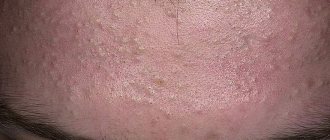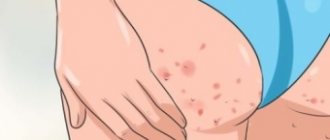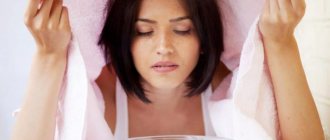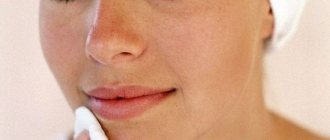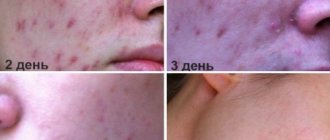Any rash on the face is noticeable. But subcutaneous acne on the chin causes not only psychological, but also physical discomfort. The skin here turns red and swells with tubercles, it is painful to touch. Dealing with subcutaneous pimples on the chin on your own is problematic - they take a long time to mature and cannot be squeezed out. For therapy to be effective, you must first find out the cause of their appearance by consulting with specialists. The treatment regimen and recommended medications vary depending on what caused the appearance of subcutaneous acne on the chin.
…
Subcutaneous acne on the chin in women: causes of appearance
Why does “subcutaneous acne” occur? How to deal with it correctly?
The activity of microorganisms as the cause of acne and subcutaneous pimples
Fungi, bacteria and subcutaneous mites can be perceived by the body as foreign (= dangerous) bodies. Therefore, leukocytes immediately enter the battle, and purulent contents appear in place of the subcutaneous pimple.
If the acne disappears, a scar or scar may well appear in its place.
Disturbances in the body, problems with hormones
For patients aged 10-17 years, this is normal: puberty occurs, hormones go crazy.
Girls of reproductive age may experience subcutaneous acne during PMS.
Stressful lifestyle, problems with the autonomic system
If you constantly experience stress, worry about little things and trifles, then “subcutaneous” acne in the chin area tells about this.
If there is a subcutaneous pimple on the chin and a bump appears, then there is a failure in the autonomic system. It causes the active proliferation of bacteria, a temporary or permanent increase in the tone of the innervation of the sebaceous glands by the vagal nerve.
This provokes hyperproduction of sebum.
Environmental exposure as one of the factors in the development of subcutaneous acne
If you don't want to face numerous redheads in this area of your face, take care of your skin. You are contraindicated:
- Exposure to ultraviolet radiation.
- Change in temperature (when yesterday it was -20 degrees, and today you went to hot countries where it’s +30).
- Ecology, dirty air, large amounts of impurities from car exhaust gases and other problems.
All this leads to an increase in the number of subcutaneous bacteria, sebum thickens and almost does not reach the surface. This provokes the appearance of acne and pimples under the skin.
Heredity as one of the key factors in the appearance of subcutaneous pimples and acne
Heredity is a factor that cannot be canceled. If your relatives (mom and dad, grandfather and grandmother) suffered from the appearance of unsightly “bumps”, there is a high probability of them occurring in you too.
In men, the Y chromosome is associated with the inheritance of globular acne, so for them the issue of heredity is even more relevant.
Allergies to food or cosmetics
The appearance of internal acne and pimples is often caused by taking medications or other drugs:
- antidepressants,
- steroid hormones,
- hormonal contraceptives.
Thus, taking antidepressants, steroid hormones, and hormonal contraceptives can cause hormonal imbalance.
If you don’t know why subcutaneous pimples appear on your chin, think about the pills and vitamins you took. Sometimes subcutaneous acne appears after taking medications for allergies and vitamin deficiency.
Poor nutrition, consumption of fatty, smoked and other harmful foods
If you eat too many sweets (chocolates, buns, cakes, cookies), this provokes active work of the pancreas.
It produces more and more insulin, which causes testosterone levels to rise. Increased testosterone leads to an increase in the number of bacteria.
Lack of vitamin A in the body and its consequences
If the skin lacks vitamin A, it becomes denser and drier.
It is important for you to be careful: a sufficient amount of retinol must be supplied with food. The compound is found in vegetables, fruits, cereals
Presence of serious illnesses
If your subcutaneous acne does not clear up using conventional methods, consult a doctor. Perhaps behind the red, painful bumps are hidden:
- diseases of the digestive system (constipation, gastritis, gallstones and others),
- problems of the excretory system (pyelonephritis, with this disease the kidneys do not remove toxins),
- diseases of the reproductive system (STIs, consequences of abortion, erosion of the cervix, gynecological operations - all this affects the process of production of sex hormones),
- problems of the endocrine system (perhaps subcutaneous acne arose due to increased testosterone levels caused by an adrenal tumor).
Result of mechanical action
If you tried to squeeze pimples or blackheads, you could damage your skin. As a result, the substances went “inside” and an inflammatory process began there.
Treatment methods
It is necessary to treat acne in such a way as to achieve several goals at once: reduce seborrhea, provide anti-inflammatory therapy, prevent the development of secondary infection and restore normal patency of the sebaceous glands. In this case, you need to carry out skin cleansing procedures carefully, otherwise scars and redness will remain.
Before choosing treatment for subcutaneous acne on the chin, you need to pay attention to the duration of the disease, the patient’s working conditions, heredity and the presence of other diseases, the manifestation of allergic reactions and the seasonality of acne formation.
You can get rid of subcutaneous acne on the chin in several ways:
- following a certain diet;
- use of medications;
- cosmetic procedures;
- means of traditional medicine.
First you need to change your diet. All foods should be low in calories, limiting the amount of food that promotes the production of sebum and clogs the glands. It is better to include foods rich in zinc in your menu. Suitable beans, seafood - shrimp, mussels. Alcoholic drinks, chocolate, cheeses, spices and spicy foods are completely excluded.
Maintain a calm lifestyle. Stress, overexertion, and conflict situations should be avoided. Do not overstrain the body with heavy mental and physical stress. You can remove acne on the chin using topical medications. Dalatsin-gel is able to dry out ulcers and destroy bacteria in the skin. It is applied in the morning and before bed every day for six weeks. Skin oiliness is reduced thanks to Curiosin, it destroys acne at the base and heals wounds in a few days. In the last stages of the disease, antibiotic therapy is used.
You can contact a cosmetologist. He will give the patient a cryomassage using liquid nitrogen. Chemical peeling with anti-inflammatory substances is carried out once a week. A specialist may also offer laser resurfacing or electrocoagulation. It is possible to cure acne using traditional methods. Inflammations will go away after using masks made from honey and egg whites, washing with a decoction of calendula and chamomile, and using tinctures of celandine and St. John's wort. Natural components do not cause allergic reactions, deeply cleanse the epithelium and have a disinfecting effect.
Types of acne
Acne is divided according to age into acne of newborns or preschool children, teenage, youthful and later acne. The degree of severity is determined as follows: the face is visually divided in half by a vertical line and the number of all lesions is counted. If there are less than ten of them, then this is the first - mild - stage of the disease. The second degree is characterized by 10-30 acne, the third - 31-40 acne. The latter is considered an extremely severe stage, with more than forty pimples located on one half of the face.
Classification by shape:
- inductive;
- comedonal acne;
- spherical;
- mechanical;
- lightning;
- ordinary.
Juvenile acne usually goes away on its own after all hormonal imbalances in the body have ended. Lightning acne appears and festeres in one day. They are cleaned, but a deep scar or ulcer remains. Mechanical acne occurs due to damage to the skin. Microcysts are called spherical pimples. They can only be removed surgically; such acne cannot be pierced. Comedones are blackheads that usually do not become inflamed. Indurative ones form swelling of adjacent areas of the epithelium; after disappearance, scars remain on the skin.
The best medicines
On pharmacy shelves you can find many products that allow you to eliminate a rash on your chin at home. Getting rid of internal acne is quite difficult, but with the right medications it is quite possible. The most effective:
- Zinerit is an effective drug from the group of antibiotics. It has a pronounced antiseptic, antibacterial and anti-inflammatory effect. Available in powder form for preparing a suspension. The resulting composition is used for spot treatment of lesions for 4-8 weeks. This time is enough to completely eliminate the defect.
- Baziron AS is a drug that produces a therapeutic effect due to the content of benzoyl peroxide. The substance has antimicrobial, anti-inflammatory and drying properties, helps to get rid of acne, blackheads and comedones for 4 weeks. The medicine is available in the form of a gel for spot treatment of lesions. With prolonged use, it can provoke dry skin, itching, a feeling of tightness, and sometimes an allergic reaction.
- Levomekol is an antibiotic-based ointment with anti-inflammatory properties. Effectively eliminates even small purulent rashes. When applied to a spot, it stimulates the outflow of pus and the capsule breaking out. Used for 10-14 days. Sometimes it provokes allergic reactions, so it is recommended to consult a specialist before starting use.
- Vishnevsky ointment is a powerful remedy against large pimples with signs of suppuration. Used for spot application, it helps relieve acute signs of inflammation within 5-7 days and prevent further spread of the infection and its entry into the blood.
- Curiosin is a gel for external use based on zinc hyaluronate. When used in the affected area, it has an antiseptic effect, stimulates the processes of regeneration and tissue renewal, helps quickly eliminate the rash and prevents recurrence.
How to treat rashes and inflammation
Treatment of rashes and inflammatory processes occurring in the tissues of the epidermis is carried out only after a medical examination. A dermatologist examines the affected skin, determines the cause of the rash, and diagnoses the disease. Only after this the specialist will prescribe effective treatment and advise how to quickly cure acne and prevent the formation of a new rash.
Advice! If the appearance of acne does not cause serious health problems, you can use home remedies for treatment. In case of serious illnesses, you will have to turn to pharmaceutical drugs, which can be supplemented with proven means of alternative medicine with the permission of a doctor.
Home Recipes
The easiest way to remove chin rashes at home is to use aloe juice. Liquid extracted from the leaves of a houseplant quickly draws pus to the surface of the skin, relieves inflammation, and prevents the appearance of new formations. It’s easy to prepare the “lotion” - pick a few leaves, put them in the refrigerator for 3-5 days, after wrapping them in polyethylene film. This time is enough for the concentration of nutrients in plant materials to increase. After the leaves wilt a little, chop them and squeeze out the juice. Wipe the rashes with the resulting liquid several times a day. Store the resulting juice in the refrigerator; it is advisable to close the container tightly.
Lotion – mint, green tea
Another effective way to deal with acne is to use a homemade lotion. It is recommended to prepare the product from grains of green tea and mint leaves, which have anti-inflammatory and antibacterial properties.
Preparation:
- Rub 15 grams with your hands. grains of green tea (it is not recommended to use granules with added herbs or flavorings; the effectiveness of the product will decrease).
- Add chopped mint leaves (5 grams) to the tea powder.
- Brew the plant material with boiling water (100 ml).
- Infuse, tightly closing the container with a lid and wrapping it in a towel.
- After half an hour, strain the liquid, use a gauze cloth folded in several layers.
Wipe problem areas of the skin with the prepared product. The frequency of procedures is at least five times a day. If you have time, you can use a lotion liquid - soak a cotton pad and apply it to the area affected by the rash for a quarter of an hour.
Green ice
Ice cubes made from plant materials are an equally effective remedy against inflammatory processes in the dermis and profuse rashes. At the same time as getting rid of acne, it will be possible to improve the condition of the skin - under the influence of cold, wrinkles are smoothed out and the shade is evened out.
Preparation:
- Chop a large bunch of parsley, rub with your hands, turning into a homogeneous mass.
- Bring water to a boil, pour in the chopped herbs, you should get a paste that resembles the consistency of sour cream.
- Leave for half an hour, no need to stir.
- Divide the green mixture into molds and place in the freezer.
After freezing, you can begin the procedure - wipe the acne areas several times a day with ice cubes.
First aid in the fight against acne:
What can you buy at the pharmacy?
There are many pharmaceutical drugs that are no less effective than home remedies in dealing with skin rashes. The most commonly used treatment for rashes is salicylic acid. The medicine must be used carefully - apply only to acne, in a targeted manner. The active components of the drug can cause dry skin, so if possible, do not apply acid to clean skin. The number of procedures is only twice a day. It is not recommended to combine salicylic acid with other medications or home remedies.
Another effective quick-acting remedy is Effezel gel. The drug is applied only to the dermis occupied by acne. Distribute the product evenly on the skin and rub into the tissue with massaging movements. Use the gel morning and evening.
Gel Baziron is a drug recommended by dermatologists against rashes and inflammatory processes. The medicine affects the sebaceous glands, reduces their activity and destroys pathogenic bacteria that cause acne. The only drawback of the product is that the duration of treatment can last for several months.
Prevention
Preventing acne on the chin is possible through various measures.
- A special diet based on seasonal fruits and vegetables in combination with fermented milk products;
- Refusal of sweets, caffeine, alcoholic beverages, minimizing the consumption of nuts and eggs, spicy, fatty foods;
- Drink 2 liters of liquid per day - pure water, green tea without sugar, fruit drinks and natural juices;
- Attentive attitude to care, 2 times a week resort to scrubs (in the absence of inflammation) and masks with an antibacterial effect;
- If you are prone to rashes, disinfect your mobile phone with antiseptics, touch your face only with clean hands, use a separate towel;
- Regular intake of multivitamin complexes;
- Applying protective ointments when going outside on frosty days and hot sunny days.
What to do if you urgently need to get rid of a pimple?
The fastest option for dealing with a pimple is squeezing.
The process itself must be carried out following strict rules. But this does not guarantee a positive outcome. The resulting hole becomes an open path for bacteria, which, if deeply penetrated, can cause inflammatory processes or even blood poisoning. Proper treatment of the pimple removal site will help to avoid negative consequences.
One of the popular methods is the rapid removal of an inflamed point using toothpaste. To do this, just apply toothpaste to the affected area and leave for 5-7 minutes. After the time has passed, press a sponge soaked in hot water onto the pimple. After 2 minutes, you can wash off the remaining paste. In most cases, the pimple disappears.
Dermatologist
This is the name of a doctor whose task is to relieve patients of various skin problems. What should you do if something like this bothers you? The best treatment is to make an appointment with a dermatologist. The fact is that you can endlessly search for advice on how to get rid of internal acne, but only a doctor is able to correctly assess the condition of the skin, conduct the necessary tests, and easily navigate the variety of medications and folk remedies.
It is important to consult a doctor if the cause of acne is unknown.
A cosmetologist is another specialist who brings the skin to a normal state. If the dermatologist does not find any problems in his area, he may recommend contacting a cosmetologist. You will be offered skin cleansing and other similar procedures.
Let's talk further about what kind of treatment for internal acne on the face can be carried out, including at home.
Products for lubricating the wound in the first minutes after removing a pimple
If it so happens that your hands reach out to the pimple in order to squeeze it out, leaving a wound, you need to immediately provide first aid to your affected skin.
In this situation, you need to correctly navigate which drugs from your home medicine cabinet can help you and which cannot. Open wounds, abrasions and scratches should not be cauterized:
- Not diluted with alcohol or alcohol-based products. After this treatment, the damage is disinfected and dried, but red spots or scars may remain in their place, which will be much more difficult to get rid of.
- Dimexide. This remedy is often recommended for treating open acne wounds. But the drug is fraught with a hidden threat, because lubricating the skin with an incorrectly diluted liquid can lead to serious burns.
Instead of alcohol and Dimexide, you can use regular baby soap and water for wiping. Before starting this procedure, be sure to wash your hands with soap to avoid infection.
The following two remedies will help you treat the wound safely:
- Calendula tincture – dries and heals open, affected areas of the skin. It can only be used diluted with water at room temperature.
- Vishnevsky ointment - used when there is pus in an open wound left after unsuccessfully squeezing out a pimple. The ointment is applied to the problem area, covered with a cotton pad and secured with an adhesive plaster.
It is recommended to use calendula in the morning or before bed, and leave Vishnevsky ointment on the face for at least three hours, and preferably all night.
Localization
Internal acne can form on any part of the body. In some cases, based on the location of the comedones, it is possible to determine what caused it.
Most often they appear on the face, but can also be localized on other parts of the body:
- rashes on the forehead and chin occur as a result of changes in hormone levels in the body and problems with the functioning of the endocrine glands;
- a subcutaneous pimple near the nose can occur due to poor cleansing of the skin or as a consequence of a cold;
- comedones on the nose can be a consequence of a cold, or indicate problems with the liver or vascular system;
- rashes in the ear appear as a result of a pathological process in the nasopharynx, which is bacteriological in nature
Comedones under the eyes can form due to malfunctions of the adrenal glands and kidneys. Large subcutaneous formations may appear in those areas of the body where large sweat glands are located.
Types of subcutaneous formations on the face
Before removing acne from the chin, you need to determine what type of acne has occupied the skin. Most often, scatterings of small pimples form on the dermis, which appear due to poor nutrition or mistakes made in care.
Another type of formation on the skin is purulent acne. The reason for their formation is inflammatory processes occurring in the tissues of the dermis. In addition to inflammation, a bacterial infection often develops.
The most painful and unpleasant are internal acne. They form after an infectious infection or a severe cold. The penetration of staphylococci into the ducts brings additional problems - long-term treatment is required.
Causes
Rashes on the face can appear due to poor hygiene or an unhealthy lifestyle. Poor nutrition, smoking, alcohol in large quantities and other bad habits greatly worsen your overall health and lead to a decrease in immunity. And since one of the causes of acne is bacteria, a weakened body cannot effectively fight them.
Hormonal changes can also trigger breakouts. Acne on the chin, common during adolescence, occurs because during this period of life the glands produce too much sebum, which clogs the pores. This kind of acne is quite long and difficult to treat.
Hormones can cause acne on the chin in women during pregnancy, after childbirth, before menstruation, and also in the presence of diseases of the reproductive system. Therefore, representatives of the fair sex are more often susceptible to skin rashes.
The cause of acne on the chin and other parts of the face can also be a hereditary predisposition when a person has an oily skin type. If you do not take special care of it, then excess sebum clogs the pores and a rash appears.
Pimples under the chin usually occur if there are already blemishes on the face. Basically, they are less painful, not so noticeable to others and are treated in the same way as on other areas of the skin.
Differential diagnosis
It is necessary to differentiate acne:
- With cold herpes. The reason for its development is infection with a virus. Infection with it has a characteristic clinical picture. The disease begins with a general malaise and only then a rash appears on the chin, which clusters around some wound or abrasion.
- With sebaceous gland adenoma. Its development begins in early childhood even before signs of inflammation of the skin of the chin appear.
- With keratosis pilaris. When it forms, there is a keratosis plug in the center of inflammation, but acne does not have one.
- With molluscum contagiosum. It has a depression in the center. The papule itself has a translucent structure.
- With steroid acne. They appear only when taking glucocorticoids. When the drug is discontinued, the skin rashes disappear.
- With flat warts. They have the shape of a papule, which does not differ from the color of the skin. Externally, a wart looks like a thin plaque.
If internal pathologies are suspected, the patient is sent for an extensive diagnostic examination.

